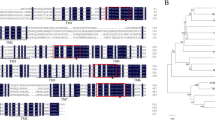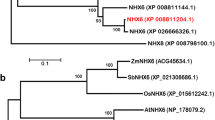Abstract
Potassium channels are important for many physiological functions in plants, one of which is to regulate plant adaptation to stress conditions. In this study, a K+ channel PutAKT1 cDNA was isolated from the salt-tolerant plant Puccinellia tenuiflora. A phylogenetic analysis showed that PutAKT1 belongs to the AKT1-subfamily in the Shaker K+ channel family. PutAKT1 was localized in the plasma membrane and it was preferentially expressed in the roots. The expression of PutAKT1 was induced by K+-starvation stress in the roots and was not down-regulated by the presence of excess Na+. Arabidopsis plants over-expressing PutAKT1 showed enhanced salt tolerance compared to wild-type plants as shown by their shoot phenotype and dry weight. Expression of PutAKT1 increased the K+ content of Arabidopsis under normal, K+-starvation, and NaCl-stress conditions. Arabidopsis expressing PutAKT1 also showed a decrease in Na+ accumulation both in the shoot and in the root. These results suggest that PutAKT1 is involved in mediating K+ uptake (i) both in low- and in high-affinity K+ uptake range, and (ii) unlike its homologs in rice, even under salt-stress condition.








Similar content being viewed by others
References
Amtmann A, Sanders D (1999) Mechanisms of Na+ uptake by plant cells. Adv Bot Res 29:75–112
Arango M, Gévaudant F, Oufattole M, Boutry M (2003) The plasma membrane proton pump ATPase: the significance of gene subfamilies. Planta 216:355–365
Ardie SW, Xie L, Takahashi R, Liu S, Takano T (2009) Cloning of a high-affinity K+ transporter gene PutHKT2;1 from Puccinellia tenuiflora and its functional comparison with OsHKT2;1 from rice in yeast and Arabidopsis. J Exp Bot 60:3491–3502
Basset M, Conejero G, Lepetit M, Fourcroy P, Sentenac H (1995) Organization and expression of the gene coding for the potassium transport system AKT1 of Arabidopsis thaliana. Plant Mol Biol 29:947–958
Blumwald E, Aharon GS, Apse MP (2000) Sodium transport in plant cells. Biochim Biophys Acta 1465:140–151
Boscari A, Clement M, Volkov V, Golldack D, Hybiak J, Miller AJ, Amtmann A, Fricke W (2009) Potassium channels in barley: cloning, functional characterization and expression analyses in relation to leaf growth and development. Plant Cell Environ 32:1761–1777
Buschmann PH, Vaidyanathan R, Gassmann W, Schroeder JI (2000) Enhancement of Na+ uptake currents, time-dependent inward-rectifying K+ channel currents, and K+ channel transcripts by K+ starvation in wheat root cells. Plant Physiol 122:1387–1397
Clough SJ, Bent AF (1998) Floral dip: a simplified method for Agrobacterium-mediated transformation of Arabidopsis thaliana. Plant J 16:735–743
Demidchik V, Maathuis FJM (2007) Physiological roles of nonselective cation channels in plants: from salt stress to signaling and development. New Phytol 175:387–404
Demidchik V, Tester M (2002) Sodium fluxes through nonselective cation channels in the plasma membrane of protoplast from Arabidopsis roots. Plant Physiol 128:379–387
Dreyer I, Blatt MR (2009) What makes the gate? The ins and outs of Kv-like K+ channels in plants. Trends Plant Sci 14:383–390
Flowers TJ, Colmer TD (2008) Salinity tolerance in halophytes. New Phytol 197:945–963
Flowers TJ, Yeo AR (1995) Breeding for salinity resistance in crop plants: where next? Aust J Plant Physiol 22:875–884
Fuchs I, Stölzle S, Ivashikina N, Hedrich R (2005) Rice K+ uptake channel OsAKT1 is sensitive to salt stress. Planta 221:212–221
Gambale F, Uozumi N (2006) Properties of Shaker-type potassium channels in higher plants. J Membr Biol 210:1–19
Gierth M, Maser P, Schroeder JI (2005) The potassium transporter AtHAK5 functions in K+ deprivation-induced high-affinity K+ uptake and AKT1 K+ channel contribution to K+ uptake kinetics in Arabidopsis roots. Plant Physiol 137:1105–1114
Hirsch RE, Lewis BD, Spalding EP, Sussman MR (1998) A role for the AKT1 potassium channel in plant nutrition. Science 280:918–921
Ivashikina N, Becker D, Ache P, Meyerhoff O, Felle HH, Hedrich R (2001) K+ channel profile and electrical properties of Arabidopsis root hairs. FEBS Lett 508:463–469
Kaddour R, Nasri N, M’rah S, Berthomieu P, Lachaâl M (2009) Comparative effect of potassium in K and Na uptake and transport in two accessions of Arabidopsis thaliana during salinity stress. C R Biol 332:784–794
Kumar S, Nei M, Dudley J, Tamura K (2008) MEGA: a biologist-centric software for evolutionary analysis of DNA and protein sequences. Brief Bioinform 9:299–306
Lagarde D, Basset M, Lepetit M, Conejero G, Gaymard F, Astruc S, Grignon C (1996) Tissue-specific expression of Arabidopsis AKT1 gene is consistent with a role in K+ nutrition. Plant J 9:195–203
Maathuis FJM, Amtmann A (1999) K+ nutrition and Na+ toxicity: the basis of cellular K+/Na+ ratios. Ann Bot 84:123–133
Maathuis FJM, Sanders D (2001) Sodium uptake in Arabidopsis roots is regulated by cyclic nucleotide. Plant Physiol 127:1617–1625
Maser P, Eckelman B, Vaidyanathan R, Horie T, Fairbairn DJ, Kubo M, Yamagami M, Yamaguchi K, Nishimura M, Uozumo N, Robertson W, Sussman MR, Schroeder JI (2002) Altered shoot/root Na+ distribution and bifurcating salt sensitivity in Arabidopsis by genetic disruption of the Na+ transporter AtHKT1. FEBS Lett 531:157–161
Muller PY, Janovjak H, Miserez AR, Dobbie Z (2002) Processing of gene expression data generated by quantitative real-time RT-PCR. BioTechniques 32:1372–1379
Navarre C, Goffeau A (2000) Membrane hyperpolarization and salt sensitivity induced by deletion of PMP3, a highly conserved small protein of yeast plasma membrane. EMBO J 19:2515–2542
Obata T, Hiroko KK, Nakamura A, Fukuda A, Tanaka Y (2007) Rice shaker potassium channel OsKAT1 confers tolerance to salinity stress on yeast and rice cells. Plant Physiol 144:1978–1985
Peng YH, Zhu TF, Mao YQ, Wang SM, Su WA, Tang ZC (2004) Alkali grass resists salt stress through high [K+] and an endodermis barrier to Na+. J Exp Bot 55:939–949
Pilot G, Pratelli R, Gaymard F, Meyer Y, Sentenac H (2003a) Five-group distribution of the Shaker-like K+ channel family in higher plants. J Mol Evol 56:418–434
Pilot G, Gaymard F, Mouline K, Cherel I, Sentenac H (2003b) Regulated expression of Arabidopsis K+ channel genes involved in K+ uptake and distribution in the plant. Plant Mol Biol 51:773–787
Qi Z, Spalding EP (2004) Protection of plasma membrane K+ transport by the salt overly sensitive1 Na+/H+ antiporter during salinity stress. Plant Physiol 136:2548–2555
Rubio F, Nieves-Cordones M, Alemán F, Martinez V (2008) Relative contribution of AtHAK5 and AtAKT1 to K+ uptake in the high-affinity range of concentrations. Physiol Plant 134:598–608
Schachtman DP, Liu W (1999) Molecular pieces to the puzzle of the interaction between potassium and sodium uptake in plants. Trends Plant Sci 4:281–287
Shabala S, Cuin TA (2008) Potassium transport and plant salt tolerance. Physiol Plant 133:651–669
Shabala S, Shabala L, Van Volkenburgh E (2003) Effect of calcium on root development and root ion fluxes in salinised barley seedlings. Funct Plant Biol 30:507–514
Shabala S, Cuin TA, Newman IA, Shabala S (2005) Salinity-induced ion flux patterns from excised roots of Arabidopsis sos mutants. Planta 222:1041–1050
Su H, Golldack D, Katsuhara M, Zhao C, Bohnert HJ (2001) Expression and stress-dependent induction of potassium channel transcripts in the common ice plant. Plant Physiol 125:604–614
Véry AA, Sentenac H (2003) Molecular mechanisms and regulation of K+ transport in higher plant cells. Annu Rev Plant Biol 54:575–603
Volkov V, Amtmann A (2006) Thellungiella halophila, a salt tolerance relative of Arabidopsis thaliana, has specific root ion-channel features supporting K+/Na+ homeostasis under salinity stress. Plant J 48:342–353
Wang SM, Zhao GQ, Gao YS, Tang ZC, Zhang CL (2004) Puccinellia tenuiflora exhibits stronger selectivity for K+ over Na+ than wheat. J Plant Nutr 27:1841–1857
Wang B, Devenport RJ, Volkov V, Amtmann A (2006) Low unidirectional sodium influx into root cells restricts net sodium accumulation in Thellungiella halophila, a salt-tolerant relative of Arabidopsis thaliana. J Exp Bot 57:1161–1170
Wang CM, Zhang JL, Liu XS, Li Z, Wu GQ, Cai JY, Flowers TJ, Wang SM (2009) Puccinellia tenuiflora maintains a low Na+ level under salinity by limiting unidirectional Na+ influx resulting in a high selectivity for K+ over Na+. Plant Cell Environ 32:486–496
Zimmermann S, Talke I, Ehrhardt T, Nast G, Müller-Röber B (1998) Characterization of SKT1, an inwardly rectifying potassium channel from potato, by heterelogous expression in insect cells. Plant Physiol 116:879–890
Acknowledgments
This work was supported by a Grant-in-aid for Scientific Research (21380002) to T.T. and by JSPS AA Science Platform Program. The authors are grateful to Dr. M. Fujimoto (Laboratory of Plant Molecular Genetics, the University of Tokyo) for his help with the technique of GFP observations.
Author information
Authors and Affiliations
Corresponding author
Additional information
Communicated by E. Guiderdoni.
Electronic supplementary material
Below is the link to the electronic supplementary material.
Rights and permissions
About this article
Cite this article
Ardie, S.W., Liu, S. & Takano, T. Expression of the AKT1-type K+ channel gene from Puccinellia tenuiflora, PutAKT1, enhances salt tolerance in Arabidopsis . Plant Cell Rep 29, 865–874 (2010). https://doi.org/10.1007/s00299-010-0872-2
Received:
Revised:
Accepted:
Published:
Issue Date:
DOI: https://doi.org/10.1007/s00299-010-0872-2




